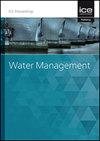靖江下游弯道的横截面几何特征
IF 0.9
4区 工程技术
Q3 ENGINEERING, CIVIL
Proceedings of the Institution of Civil Engineers-Water Management
Pub Date : 2024-04-15
DOI:10.1680/jwama.23.00062
引用次数: 0
摘要
上游大坝筑坝后,河道中的条池形态演变对河道整治、航运、取水口和防护工程都有重要影响。本文报告并分析了三峡大坝蓄水后下荆江河段(LJR)沿线弯道的条池构造演变,并将其与弯道的自然演变区分开来。三峡大坝蓄水前后,入库流量和泥沙态势的变化是造成拦河坝-坝池结构不同调整的主要因素。为了捕捉条形水池构造的变化,我们提出了一种新的断面几何特征--中心点相对横向距离(RLDC)。RLDC 与入库泥沙系数(即汛期入库流量除以悬浮泥沙浓度)关系密切。RLDC 比传统的断面几何特征(如宽深比)更能说明大型水坝工程下游的条形库构造。根据延迟响应模型,洛阳江河弯曲处的 RLDC 值与前 4-6 年的入库泥沙系数相关,相关系数约为 0.90。预计 RLDC 可捕捉到大坝工程下游弯曲处的条池构造变化。本文章由计算机程序翻译,如有差异,请以英文原文为准。
Cross-sectional geometrical characteristic for the bends along the lower Jingjiang reach
The evolution of the bar-pool configurations in response to the upstream damming has significant impacts on channel regulations, navigations, water intakes and protection projects. Herein, this paper reports and analyses the evolution of bar-pool configurations in the bends along the Lower Jingjiang Reach (LJR) after the impoundment of the Three Gorge Dam (TGD), which is distinguished from the natural evolution of the bends. The main factors to the different adjustments of bar-pool configurations are the changes in incoming flow and sediment regime during pre- and post-TGD periods. To capture the changes in the bar-pool configurations, we have presented a new cross-sectional geometrical characteristic - relative lateral distance of the centroid (RLDC). RLDC has close relations with incoming sediment coefficient (i.e. incoming discharge divided by suspended sediment concentration during flood season). RLDC is better than the conventional cross-sectional geometrical characteristic (e.g. width to depth ratio) to indicate the bar-pool configurations of the downstream of the large dam projects. Based on the delayed response model, the values of RLDC in the bends of the LJR are related to the previous 4-6 years’ incoming sediment coefficient, and the correlation coefficient is about 0.90. RLDC is expected to capture the variations of bar-pool configurations in the bends downstream of the large dam project.
求助全文
通过发布文献求助,成功后即可免费获取论文全文。
去求助
来源期刊
CiteScore
2.10
自引率
0.00%
发文量
28
审稿时长
6-12 weeks
期刊介绍:
Water Management publishes papers on all aspects of water treatment, water supply, river, wetland and catchment management, inland waterways and urban regeneration.
Topics covered: applied fluid dynamics and water (including supply, treatment and sewerage) and river engineering; together with the increasingly important fields of wetland and catchment management, groundwater and contaminated land, waterfront development and urban regeneration. The scope also covers hydroinformatics tools, risk and uncertainty methods, as well as environmental, social and economic issues relating to sustainable development.

 求助内容:
求助内容: 应助结果提醒方式:
应助结果提醒方式:


